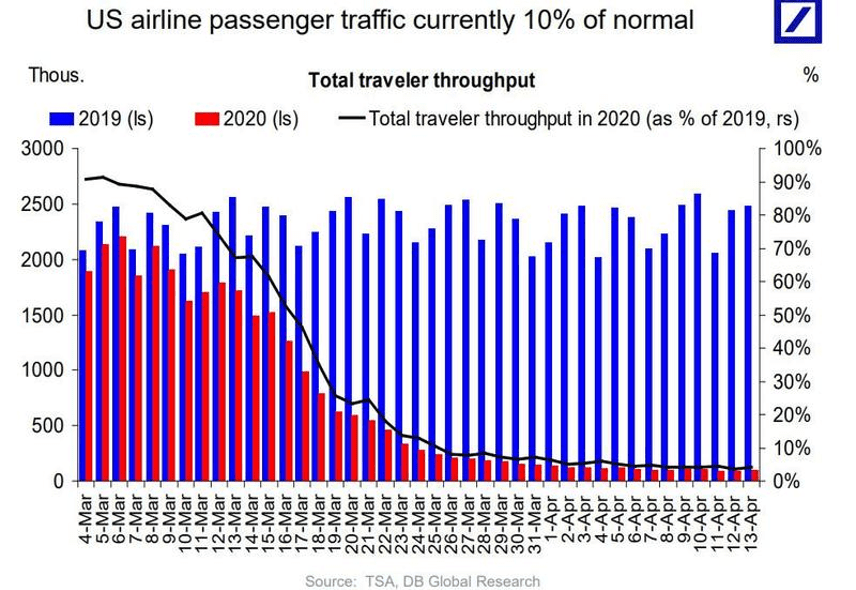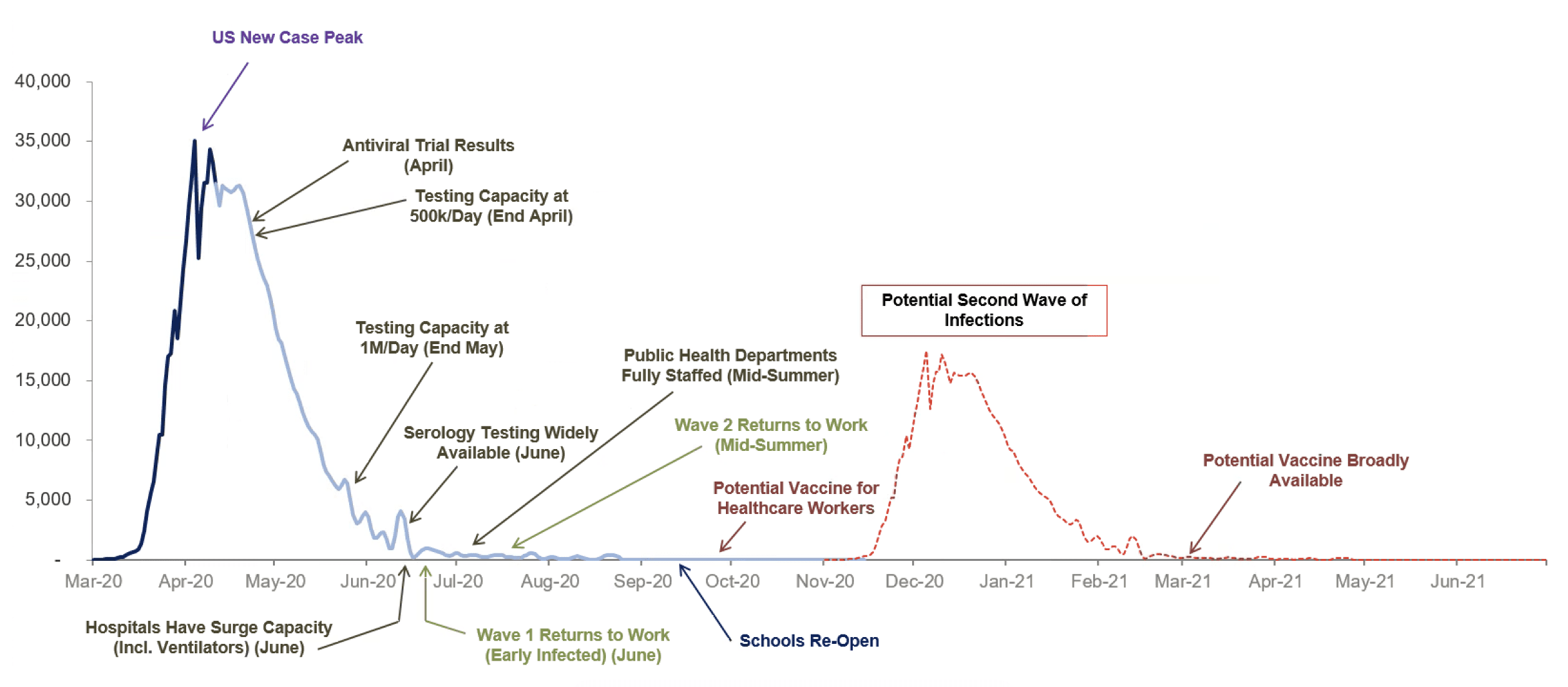As transit systems facilitate increased accessibility to public spaces and businesses, their ability to inspire consumer confidence will be an important catalyst for reinvigorating broader economic activity. This role underscores the importance of facilitating effective communication and coordination, ensuring vigilance to risk mitigation measures, and modifying practices to adapt to consumer behavior.
Transit systems have been subject to many of the heaviest impacts from COVID-19, particularly as the pandemic continues to drive a steep decline of local transit ridership – a drop exceeding 70% in areas across the United States. Air transit enplanement has taken an even sharper decline, with a 95% decline in total traveler throughput since March 1.
Meanwhile, over $2 trillion in economic relief was released under the Coronavirus Aid, Relief, and Economic Security (CARES) Act, which includes funding packages specifically to support transit systems through these challenges. This funding will be deployed in multi-million-dollar grants and loans to transit systems to recoup losses, improve systems, and procure resources.

Mapping the Landscape
It is essential to understand the broad national context of the COVID-19 pandemic, which exhibits a non-linear progression of pandemic spread and reemergence. Pandemic spread can be characterized by multiple data points, including the total number of confirmed cases, number of patient hospitalizations and fatalities, and the number of residents with confirmed exposure to COVID-19 (e.g., under quarantine). The progression of both confirmed cases and potential exposure will be an important guide for transit systems as they work to establish a “new normal” in which operational needs are balanced with social distancing – all while simultaneously supporting public participation in safe and healthy reopened economies.
The below graphic provides insight into the projected return to work timeline for the country. It indicates there will be multiple waves of individuals returning to work based on when the peak in new cases occurred in their region.
Graph: Source
Transit systems can expect varying trends in their own ridership and ability to reach projected milestones for a returning workforce. Most local transit systems – buses, local rail, subway – can expect trends that will be closer to their local economies reopening. This will vary for urban areas, depending the local population’s use of and access to cars, as well as public confidence in the safety of mass transit. Regional and national transit infrastructure, particularly air transit, will likely follow a slower progression to reopen since it is not integrated into localized daily life. Challenges to reopening air transit will be further undercut by the availability of remote work and teleconferencing options, as well as the currently low public confidence in the safety of flying.

Prepared to U-Turn: Enabling an Adaptive Approach
The transformations to transit infrastructure – including physical environment retrofits, new fare policies, revisited and improved health practices, and revised continuity of operation planning – present an important and unique opportunity to shape public confidence in what will ultimately be a new practices for transit systems, with advanced health and safety protocols.
TRANSIT SYSTEMS & COVID-19:
THE NEXT STEPS FOR THE SAFE RESUMPTION OF SERVICES
As they implement these changes, transit systems require a data-driven approach to maintain timely and accurate surveillance of the real-time pandemic spread. This includes active monitoring of both national and local data, as well as local health department updates, to ensure that operational protocol is adapting and responding to situational changes as they happen.
COVID-19 is not a linear event and will require the capability to turn measures “on” and “off” based on evolving data, public needs, and official guidance. Especially as economies reopen and soften mitigation measures, transit systems should be prepared to take a U-turn — return to a previous stage — if the public health information available makes it necessary to reevaluate the current posture. Transit partners should work in tandem with cross-functional local, state, and regional teams to ensure a unified vision – and a common set of facts – is informing decisions.
Transit operational decision making should also include location and demographic-specific considerations. The unique connection between transit systems and multiple community environments will require transit operations to translate effectively between economies where reopening is underway, and those still under strict regulations. These differences underscore the importance of maintaining regular community-level engagement to effectively track how those environments are changing.
When communities do begin to depart from the most serious phases of the pandemic, older adults and populations at risk may also require continued physical distancing measures and avoidance of any non-essential travel.

Road to Recovery
Official guidance from transportation and health officials encompass best practices and strategies from across the United States, as transit systems innovate their essential operations during COVID-19. Hagerty is amplifying the importance of these measures through guidance on five critical strategies to build into what are increasingly proactive operational protocols across the transit industry. These measures emphasize the importance of adapting physical spaces, messaging, and assessments to evolve transit systems with fast-acting tools that facilitate confident public movement without compromising public health or safety. As a product of these efforts, transit systems will underscore a broader vision of reopened communities within a “new normal”.
TRANSIT RESPONSE & RECOVERY SERVICES OVERVIEW
RECOMMENDATIONS DEVELOPED BY THE HAGERTY TRANSIT TEAM:
Becky Brocker, Thea Credle, Tylor Headrick, Jim McIntosh, Ashley Saulcy, and Tim Schaible
STAY UPDATED AND LEARN MORE HERE:
- American Public Transportation Association’s Public Transportation Responds: Safeguarding Riders and Employees
- Federal Aviation Administration’s Novel Coronavirus (COVID-19) Update
- John Hopkins University’s Coronavirus COVID-19 Global Cases Map
- 2019 Novel Coronavirus Situation Updates by CDC
- World Health Organization Coronavirus Information
Keep track of Hagerty’s Incident coverage here:
DISASTER DISCOURSE CORONAVIRUS UPDATES


